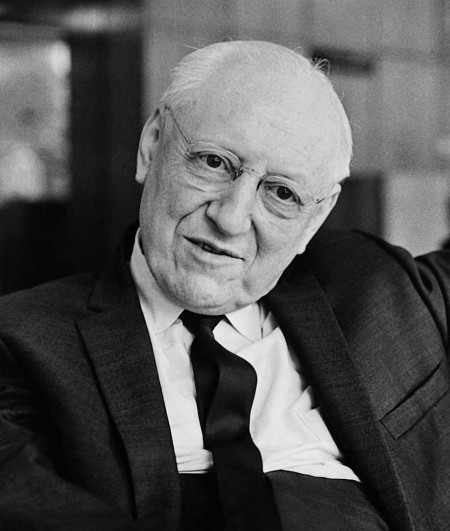(Kocs, 8 December 1903 – Calgary, 5 October 2001)
Zoltán Székely Hungarian violinist living in Canada was a significant representative of the school of Hubay. He achieved international fame as a soloist and as the first violinist of the Hungarian Quartet, as well. He was one of the most outstanding violinist partners of Bartók that gives music historical significance to his career. The composer dedicated his Rhapsody No.2 in 1928 to him and wrote his Violin Concerto on his request in 1937/1938. The String Quartet No.6 of Bartók was also written for the Hungarian Quartet originally, though because of their personal relationship was interrupted during World War II and Bartók's emigration to America the Kolisch Quartet received the dedication finally.
Székely was admitted to the Academy of Music in Budapest at the age of 11, where he studied between 1915 and 1921. He could enter the academic classes in the academic year of 1917/1918 and then his professor became Jenő Hubay following his former teacher József Bloch. The relationship of master and disciple - according to the recollections of Székely – could not be particularly good. From his class Ede Zathureczky was Hubay's favorite student. The interest of the young violinist turned soon to new Hungarian music. He took private composition lesson with Kodály from 1918 with his friend Pál Hermann, who was a cellist. By him he got acquainted in the spring of 1921 with Bartók, at the request of whom they performed together several times playing the Violin Sonata of Debussy and premiering Szymanowski's Mythes in Budapest among others. In autumn of the same year Székely performed Brahms' Violin Concerto, Hubay's Concerto all'antica and Sibelius' Violin Concerto (dedicated to Ferenc Vecsey) at his degree recital.
The starting point for his international career became the Netherlands. In 1922 he was provided accommodation by the Everts family who participated in an action of the Red Cross helping Hungarian children. A friendship developed immediately between him and his to be wife Igminia (Mientje) Everts (1898–1990). His performance of his own Violin Sonata written in 1920 gained the critics' and composers' attention in 1925 at the festival of the International Society for New Music in Venice. (According to the memories of Mientje Schoenberg and Stravinsky was also clapping by standing on their chairs in the Teatro Fenice.) That composition as well as some of his later chamber works was published by the Viennese Universal Edition. He dedicated the Sonata for Jaap de Graaf to whom he could thank later the purchase of his Stradivary instrument of 1718. The frequently performed arrangement of Székely of Bartók's Rumanian Folk Dances was published in 1926. At that time works by Ravel (Sonata, Tzigane), Casella, Bloch and other composers were included in his programs. In November of 1929 Szigeti premiered the Rhapsody No.1 in its orchestral version and Székely the Rhapsody No. 2 also in its orchestral version, almost immediately after each other, and then it was also him who performed both in their original versions with piano accompaniment, with Bartók at the piano. In opposition to the condemnatory criticism of Emil Haraszti following the second orchestral concert Bartók himself defended Székely who played his composition with ‘an ideal perfection' (Budapesti Hírlap, November 27, 1929).
Mr. and Mrs. Székely moved from the house of the Everts family in Nijmegen to Santpoort in 1935, where a villa named ‘Rhapsody' was waiting for them. The ‘New' Hungarian Quartet was founded the same year with recently graduated students of the Academy of Music: Sándor Végh (first violin), Péter Szervánszky then László Halmos (second violin), Dénes Koromzay (viola) and Vilmos Palotai (cello). The name of the ensemble was chosen with regard to the Waldbauer-Kerpely Quartet that was touring sometimes with the name Hungarian Quartet. String Quartet No. 5 of Bartók was premiered by them in 1936 in Budapest and in Vienna. Székely took over the first violinist position next year and the ensemble moved to the Netherlands. Sándor Végh who returned to Hungary soon was replaced by Alexandre Moskowsky in the second violinist position. Classical works (Haydn, Schubert) were part of their repertoire just as contemporary ones (Honegger, Milhaud, Sándor Veress). Bartók composed the Violin Concerto to the request of Székely in 1937/1938. At the last phase of compositional work composer and soloist discussed questions in connection with the technique of the instrument repeatedly. The work was premiered by Székely on March 23 in 1939 with the Concertgebouw Orchestra in Amsterdam, under the baton of Willem Mengelberg. The recording of the premiere survived.
The violinist moved to the United States in 1950. However he never gave up his career as a soloist the Hungarian Quartet remained the main territory of his activities up to 1972. The ensemble operated with the same composition between 1938 and 1956, then Gábor Magyar replaced Palotai and Mihály Kuttner replaced Moskowsky in 1959. On the repertoire of the quartet the complete string quartets of Beethoven and Bartók received a significant place. Both series were preserved on sound recordings. From 1975 Székely taught at the Banff School of Fine Arts in Canada. Several soloists and quartets (the Takács-Nagy and the Éder Quartets from Hungary) traveled to him to consult with him especially on the questions of Bartók-interpretations. A conference on the one hundredth anniversary of the composer's birth was held in 1981 with the participation of the violinist with the title "A népzene hatása Bartók műveire" (The effect of Folk Music on the Works of Bartók).
V. L.



